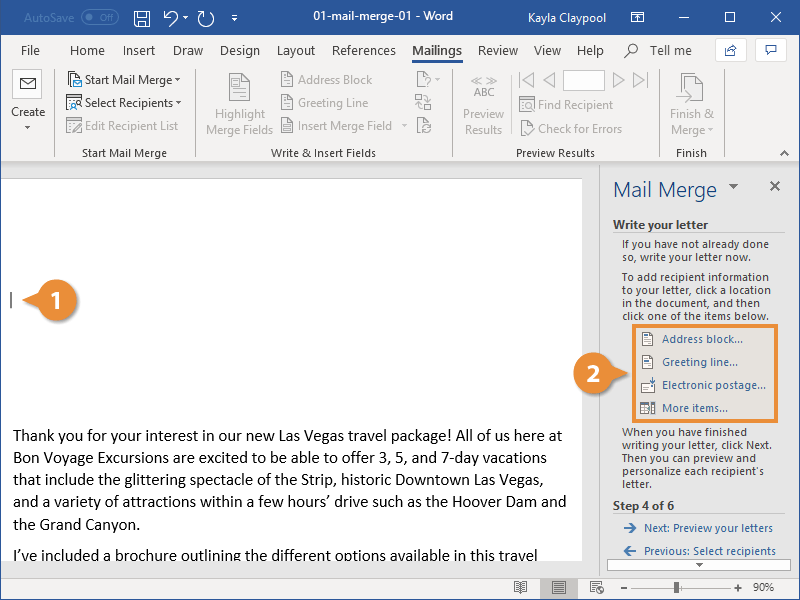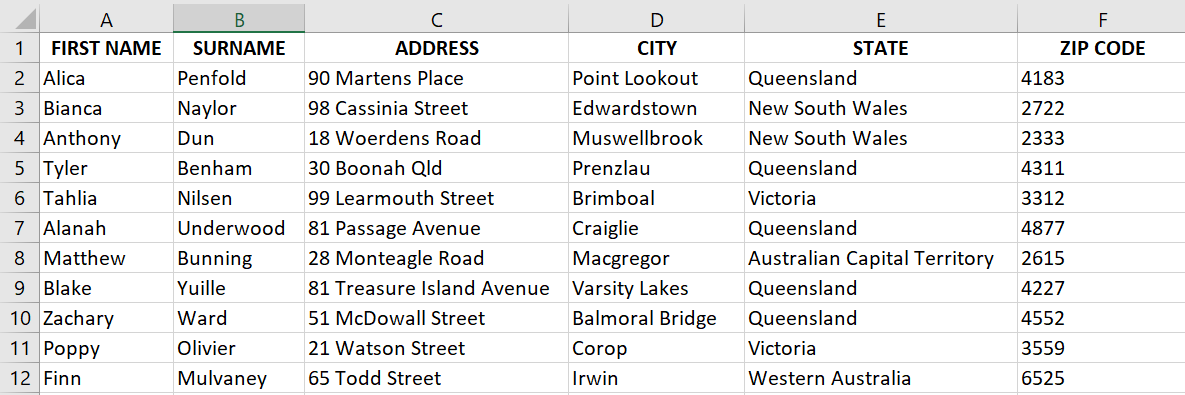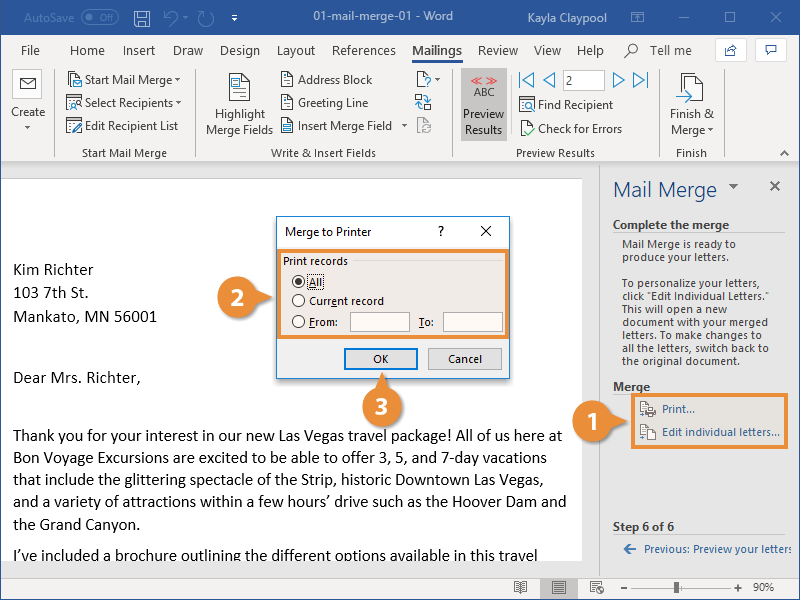

- MICROSOFT WORD MAIL MERGE FROM EXCEL HOW TO
- MICROSOFT WORD MAIL MERGE FROM EXCEL WINDOWS 8
- MICROSOFT WORD MAIL MERGE FROM EXCEL DOWNLOAD
The Using the Many to One Facility document that describes how to use that facility. That document explains how you must set up the Excel Data Source and the Mail Merge Main document to be able to execute a merge with a Chart that is unique to each record in the data source. The Mail Merging with Charts document that is also on that page. It is not actually necessary to have separate attachments as the facility can be used to send just the documents created by the merge itself as attachments, either as the body of the message itself or in the form of Word files or. If you have many, many records in your data source, though, the mail merge might not run as quickly as you like. The Merging with Attachments document that is also on that page which explains how the system is used. The Mail Merge tool in Word can be very helpful in combining information from a data source (such as names or addresses) with information in a standard document (such as letters or labels). One thing to note is that the field names in the data source must contain only alphanumeric characters (No etc) and the field names must not start

When that has been done and Word is started\re-started, the tab shown below will be added to the Ribbon: While there, it is a good idea to uncheck the box of
MICROSOFT WORD MAIL MERGE FROM EXCEL WINDOWS 8
In Windows 8 and 8.1, in the File Explorer, click on Options on the View tab of the ribbon and then on the View tab in the dialog that appears and select the item "Show hidden files, folders, and drives". Uncheck the box of "Hide extensions for known file types". In Windows 7, - In Windows Explorer, click on the Organize drop down and then on Folder and search options and in the Folder Options dialog, go to the View tab and select the item "Show hidden files, folders, and drives". In Windows Vista and Windows 7, 8 or 8.1 it isĬ:\Users\\AppData\Roaming\Microsoft\Word\STARTUP In Windows XP the default location for that folder isĬ:\Documents and Settings\\Application Data\Microsoft\Word\STARTUP The MergeTools – 20140218.dotm file needs to be saved in the Word Startup folder.
MICROSOFT WORD MAIL MERGE FROM EXCEL DOWNLOAD
You can download the MergeTools – 20140218.dotm Add-in that I created from the following page of my One Drive: Having attachments is optional and if there are none, it is just the merged document that will be emailed. DDE has now been disabled in modern Office as a security risk.I do not know that anyone has ever come across the reason for that, but it has been reported that sometimes if you first execute a merge to a plain text message, it "unblocks" the merge to HTML format.Īnother option is to use the Merge with Attachments facility on my Merge Tools Add-in and select E-mail message as the destination. There was an older ‘ Dynamic Data Exchange‘ system available for communication between Office apps. It’s the easiest to use, just insert into the merge document and it’ll appear exactly the same as in Excel. ‘PercentageasText’ locks you into a single format to display in Word. There may be cases where you use the same Excel data in different formats for the mail merge.

Probably ‘Percentagex100’ is the better choice since it sends a number (not text) to Word that you can format in any way you wish.

Įither ‘Percentagex100’ or ‘PercentageasText’ will work in a Word mail merge. PercentageasText: is the column B value converted to text (using the TEXT function) with percentage formatting applied. Percentagex100: is the fraction from column B multiplied by 100. This is the usual way percentages are handled in Excel.Īctual Value: exposes the value in column B in the way Excel stores it, in other words as a fraction. Percentage: Column B is the fraction (eg 0.12) displayed as a percentage. Here’s a sample worksheet that shows you two different ways to ‘massage’ a percentage into a Word friendly form (the data is fictional): The most direct option is to add some columns in Excel with versions of the percentage figure that you can use in Excel. Remember to press Ctrl + F9 to make the field – not the curly brackets on the keyboard. This lets you multiply the number coming from Excel by 100 before formatting. To do it embed the MERGEFIELD inside another Word field. You can change the decimal fraction (eg 0.738) to a percentage (73.8) in Word. Normally, a Word mail merge will import the raw number from Excel and let you format it in way we’ve described before.Īs usual, there’s more than one solution to the problem: Formatting in Word For example 25% is stored in Excel as 0.25. How can you put percentages into a Word mail merge?įollowing our article on importing Excel data into a Word mail merge, here are the options for using percentages.Įxcel might show a percentage but the number stored is a fraction.


 0 kommentar(er)
0 kommentar(er)
